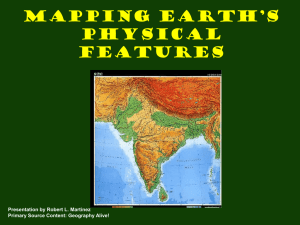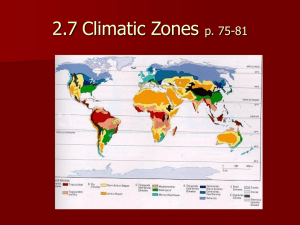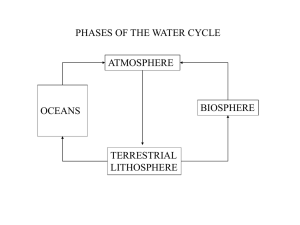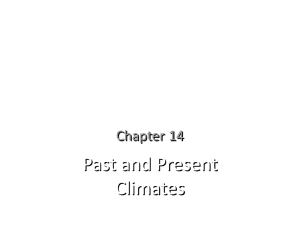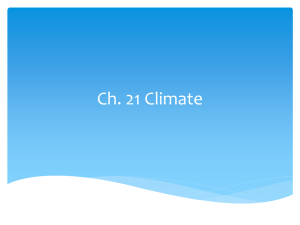Introducing the Planet - Geography, Biomes, and Species Interactions
advertisement
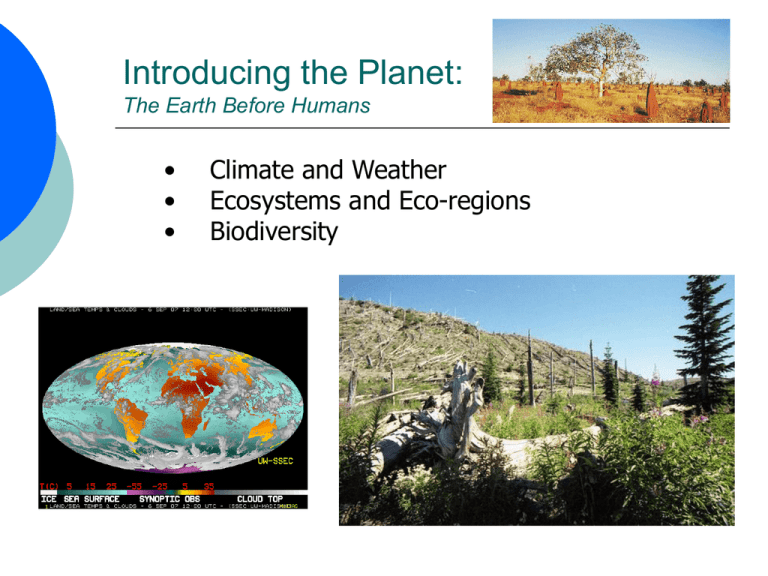
Introducing the Planet: The Earth Before Humans • • • Climate and Weather Ecosystems and Eco-regions Biodiversity Climate and Weather • Lands near the equator are, on average, warmer. Closer to either pole and the earth is colder. • High elevation locations are much colder than lower elevations. These areas also receive more precipitation. • Locations at high latitudes have extreme seasonality. Near the equator there are no seasons. • Middle latitude areas (30-60 degrees N or S) are characterized by moderate temperatures, but they experience seasons and storms associated with conflicts between cold and warm air masses. • 20% of the earth is covered with snow. • 30% of the earth is arid or desert. • Water is constantly changing states, storing and releasing huge amounts of energy, via evaporation, condensation, and freezing. Earth From Space Earth From Space (click for latest image) World Precipitation Climate Regions World Climates Selected World Climographs A Tropical Wet, hot equatorial regions, that cover about a third of Earth’s surface. Rains nearly every day. No or little seasonality. Precipitation around 80-100” annually. Frequent thunderstorms. Hurricanes. B Dry Arid and semi-arid deserts and steppes; evaporation exceeds precipitation. U.S. example: Albuquerque, New Mexico (annual precipitation, 22 cm [9 inches]). Rain falls as infrequent, but powerful, summer thunderstorms. C Mesothermal Humid subtropical, may have dry summers. Warmest month above 10oC (50oF); coldest month above 0oC (32oF) but below 18oC (64oF). U.S. example, New Orleans, Louisiana. Mid-latitude storms and thunderstorms common. D Microthermal Humid climate with long winters, mild summers. Warmest month above 10oC (50oF); coldest month below 0oC (32oF). U.S. example, Flint, Michigan. Most rain falls in mid-latitude frontal storms. E Polar No true summer, warmest month average temperatures below 10oC (50oF); always cold. U.S. example, Barrow, northern Alaska. Very short growing season. No thunderstorms. H Highland Lower temperatures and more precipitation. U.S. example, Blue Canyon, Sierra Nevada, California (annual precipitation, 170 cm [68 inches]). Very short growing season. Vegetation Regions Biomes (Ecosystems) http://www.untamedscience.com/biology/world-biomes A biome is a major class of ecologically similar communities of plants, animals, and soil organisms, often referred to as ecosystems. Biomes are defined based on factors such as plant structures (such as trees, shrubs, and grasses), leaf types (such as broadleaf and needleleaf), plant spacing (forest, woodland, savanna), and other factors like climate. Biomes are often identified with particular patterns of ecological succession and climax vegetation. Boreal Forest (Taiga) Tropical Savanna World Biomes (Click title for photographs and descriptions) Tropical Rainforest (Af) • High rainfall all year (>2” / month) • Warm every month • Precipitation exceeds evaporation. • Straddles Equator by 5o - 10o Tropical Climates (A) Tropical Climates (A) • • • • 1/3 of Earth’s total surface (about 20 ºN to 20 ºS) Consistently warm (all months > 18ºC/64.4 ºF) Daily temp range exceeds annual temp range Subcategories based on rainfall (ITCZ influence) Subcategories based on rainfall distribution: • Tropical rainforest (Af) • Tropical savanna (Aw) Tropical Rainforest (Af) • High rainfall all year (>2” / month) • Warm every month • Precipitation exceeds evaporation. • Straddles Equator by 5o - 10o Tropical Rainforest (Af) – Vegetation : Highest average biomass on earth. Highest biodiversity on earth! Thousands of species, tall trees, many canopy layers, evergreen, broadleaf trees, epiphytes, lianas (vines), climbers, stranglers, ferns – Fauna: More species than all other biomes combined!, colorful insects, amphibians, reptiles, and birds, few large animals, high density of biomass and incredible species diversity • Other: Among most threatened biomes Lianas Epiphytes Buttresses Deforestation, Malaysia Strangler Fig 3-Toed Sloth, Panama Savanna (Aw) – Tropical Grassland Climates • The tropical wet and dry or savanna (Aw) has an extended dry season during winter. • Region/Distribution: Subequatorial Africa, and South America, Southern India (25° N and S Latitude) • Vegetation: Continuous cover of grasses, scattered trees or shrubs Masai Reserve, Kenya • Other: Susceptible to desertification Acacia and Wildebeest Serengeti Plain, Tanzania Dry / Semiarid Climates (B) • Occupy about 1/3 of Earth’s land area (Most extensive climate over land surface) • Evaporation exceeds precipitation (water deficit) • Subcategories – Desert (BW) – Steppe (BS) Deserts (BW): dry Deserts (BW): Temperature: • Widest range: up to 100oF/day! • Hot at low latitudes, wide variation at higher latitudes Precipitation: • Scarce: <10 inches/year • Unreliable: wide variation from average • Intense: convective downpours Desert Causation: • High Pressure Cells and resultant stability • Rainshadows True Deserts (BW) • Vegetation: Widely scattered thorny bushes, cacti, small flowers, extensive shallow roots or long tap roots, shrubs, succulents • Fauna: Many rodents, lizards, toads, snakes and other reptiles, many birds, owls, vultures, many insects (adaptive strategies) • Other: Deserts cover roughly 1/3 of earth. May be growing due to desertification. • Steppe: semi-arid high elevation or high latitude Desert Plant Survival Strategies schlerophyllous adaptations - small, waxy leaves or thorns replace leaves succulents - stems modified to spongy water storage structures ephemerals (obligate seeders) - fast reproductive cycle wide spacing with shallow roots - collect sparse rainfall Organ Pipe Cactus Organ Pipe National Monument, Arizona Steppe (BS): temperate grasslands • more precipitation than BW • narrower temperature ranges • grasslands Temperate Grassland/Steppe (BS) • Region/Distribution: Central North America, parts of Africa, Australia, SE South America (Pampas) • Soil: very fertile soils, best on earth • Vegetation: Grass tall to short prairie, pampas, steppe. Sod forming grasses, Sparse bushes, occasional trees in some areas • Fauna: large grazing animals, bison, antelope, wild horses, kangaroos, giraffes, burrowing animals: rabbits, prairies dogs…; predators: coyotes, lions, leopards…... • Other: Most N. American grasslands have been converted to agricultural fields. Wild grazers replaced by cattle, sheep, goats. Less than 1% of original grasses left. Mesothermal Climates/Temperate (C) • True seasonality (air mass conflict) • Subdivisions based on precipitation variation – Humid Subtropical (Cfa) – Mediterranean (Cs) Humid Subtropical Broad-leaf Deciduous Forest Allegheny Mtns., Pennsylvania Mediterranean Coastal Sage Scrubland Channel Islands N.P., California Mesothermal Climates (C) Humid Subtropical (Cfa) Mediterranean (Cs) Subtropical Forest Sarasota, Florida • Hot summer, substantial Humid Subtropical year-round precipitation • Low latitude east coasts Midlatitude Forests (warm currents). • Summer max precipitation. • Cold spells; seasonality. Cfa - New Orleans, LA Temperate Broad-leafed Forest (Deciduous) • Region/Distribution: Western Europe, East Asia, Eastern U.S.. Between 30-50° north or south • Soil: brown soils, good for agriculture • Vegetation: Broad-leafed deciduous trees, (120150’ tall), oaks, hickories, maples, … • Fauna: mammals such as white tail deer, porcupines, raccoons, rabbits, squirrels, most carnivores eliminated by hunting i.e. wolf, mountain lion, bobcat; many birds; frogs and salamanders, snakes • Other: Plants and animals well adapted to seasonality including hibernation, migration Mediterranean • Dry summers (shifting subtropical highs) • Surrounds Mediterranean • Also on west coasts near 30o N and S (Australia, S. Africa, Chile) Mediterranean • Region/Distribution: West coast and Central California, SW. Australia, tip of S. Africa, West Peru. Chile, Mediterranean (good wine places!) • Vegetation: Scrubland, scattered trees (oaks, eucalyptus), grasses. Fire tolerant, sclerophyllous (hard-leafed) evergreens, chaparral (scrubby evergreen) • Fauna: Burrowers like ground squirrels, gophers; deer, mountain lions, coyotes, many birds • Other: Susceptible to fire during dry season, some species need fire to regenerate; susceptible to erosion and desertification, development; threatened biome Chaparral Manzanita Microthermal Climates (D) Only found in Northern Hemisphere • 50o-70o N latitude • long, bitterly cold winters • highest annual temp range: up to 100O F •Great annual temperature ranges (continentality, air mass conflicts) Dw – Calgary, Canada Coniferous (Boreal) Forest – Koppen D • Region/Distribution: Northern parts of North America, Europe and Asia, South So. America, much of Russia • Vegetation: Coniferous (mostly evergreen) forest, ex. Spruce, Fir, Pine, Larch, needleleaved • Fauna: Large herbivores: moose, elk; small herbivores: squirrels snowshoe hare, beaver; Predators: wolves, foxes, bears, lynx, weasel family; Mosquitoes in summer • Other: Acid rain, logging , oil drilling, hunting of predators Fir Trees, Alaska Spruce Needles British Columbia Polar Climates (E) - all months < 50OF Polar Climates (E) - all months < 50OF • Tundra (ET) – warmest month 32-50F • Ice caps (EF) – warmest month below 32F • Both have very low precipitation Koppen Classification: ET Vertical Zonation of Vegetation Vegetation Succession Pioneer Stage Climax Stage Occurs after disturbances: fires, storms, landslides, etc. Vegetation Succession Riparian Vegetation Vegetation that grows along water courses. Often supports much richer diversity of plant and animal life, including more trees in a dry environment. Sespe Wilderness near Ojai, CA Ecosystems: Food Chains Energy flows up the chain as more and more heat is lost at each trophic level. Ecosystems: Food Web “Now when you cut a forest, an ancient forest in particular, you are not just removing a lot of big trees and a few birds fluttering around in the canopy. You are drastically imperiling a vast array of species within a few square miles of you. The number of these species may go to tens of thousands. ... Many of them are still unknown to science, and science has not yet discovered the key role undoubtedly played in the maintenance of that ecosystem, as in the case of fungi, microorganisms, and many of the insects.” (E. O. Wilson, 2000) Biodiversity Biodiversity refers to diveristy of 1. Species 2. Habitats 3. Genetic Diversity (within a species) Scientists estimate that upwards of 10 million— and some suggest more than 100 million—different species inhabit the Earth. Each is uniquely adapted to a particular habitat. Scientists have discovered and named only 1.75 million species—less than 20 percent of those estimated to exist. Taxonomic Categories % of Genera Extinct in Period Mass Extinctions Millions of Years Before Present Source: Rohde, R.A. & Muller, R.A. (2005). "Cycles in fossil diversity". Nature 434: 209-210. Mass Extinctions - The Sixth Extinction Biodiversity loss and species extinction Extinction = last member of a species dies and the species vanishes forever from Earth Extirpation = disappearance of a particular population, but not the entire species globally. This is still a loss of biodiversity and ecosystem stability. These are natural processes. On average approximately one species per million goes extinct naturally in a year. This is called the background rate of extinction. Today it’s estimated that somewhere between 100 and 1000 per million become extinct each year. 99% of all species that ever lived are now extinct, but in general more species evolve over time than go extinct. There were more species on Earth at the beginning of civilization than the Earth had ever had before. Today’s mass extinction Currently Earth is about to experience its sixth mass extinction – this time because of humanity. Humans have increased the extinction rate by a factor of somewhere between 100 and 1,000! 1,100 species are known to have gone extinct in the past 400 years. The Red List, from the IUCN, lists species that today are facing high risks of extinction. The total number of known threatened species is currently above 10,500. Over 3,300 of these are vertebrates! Today’s Population Reductions and Mass Threats = Tomorrow’s Mass Extinction Event Numbers of of large mammals and birds plummeted with the arrival of humans, independently, on each of three continents— suggesting that human hunting was the cause. Figure 15.9 Causes of species extinction Primary causes spell “HIPPO”: • Habitat alteration • Invasive species • Pollution • Population growth • Overexploitation “HIPPO”: Habitat alteration The greatest cause of extinction today Accounts for 85% of population declines of birds and mammals Habitat change hurts most organisms because they are adapted to an existing habitat. Alteration due to: Forest clearing Urban development Agriculture etc…. Global climate change “HIPPO”: Invasive species Accidental or intentional introduction of exotic species to new areas Most do not establish or expand, but some do—likely because they are “released” from limitations imposed by their native predators, parasites, and competitors. In today’s globalizing world, invasive species have become perhaps the secondworst threat to native biota. “HIPPO”: Invasive species (USDA Invasive Info Center) • Mosquito fish (Australia from SE U.S.) • Zebra mussel (U.S. from Asia) • Kudzu (U.S. from Asia) • Asian long-horned beetle (U.S. from China) • Rosy wolfsnail (Hawaii from U.S. Mainland) • Cane toad (Australia) • Bullfrog (United States from U.S.) •Gypsy moth (United States from Europe)) • European starling (U.S. from Shakespeare!) • Indian mongoose (Hawaii) • Caulerpa algae (CA from aquariums) • Cheatgrass (United States from Europe) • Brown tree snake (Guam from Australia) “HIPPO”: Pollution Air and water pollution; agricultural runoff, industrial chemicals, etc. Pollution does serious and widespread harm, but is not as threatening as the other elements of HIPPO. “HIPPO”: Population growth Human population growth exacerbates every other environmental problem. Magnifies effects of the other elements of HIPPO: More people means more habitat change, more invasive species, more pollution, more overexploitation. Along with increased resource consumption, it is the ultimate reason behind proximate threats to biodiversity. “HIPPO”: Overexploitation Two meanings: Overharvesting of species from the wild (too much hunting, fishing…) Overconsumption of resources (too much timber cutting, fossil fuel use…) Usually overexploitation is not the sole cause of extinction, but it often contributes in tandem with other causes. Was more important in some cases in the past. Causes of species extinction In most cases, extinctions occur because of a combination of factors. (486 critically endangered; 43% of species in decline) e.g., current global amphibian declines are thought due to a complex combination of: Monteverde Golden Toad, Last seen 1989 • • • • • • Chemical contamination Disease transmission (fungus) Habitat loss Ozone depletion and UV penetrance Climate change Synergistic interaction of these factors The Value of Biodiversity? Food Fuel Construction Medicine Aesthetics (Beauty) Spiritual Educational Ethics The Encyclopedia of Life – http://eol.org E.O. Wilson on the Value of Biodiversity (PBS Bill Moyers Journal)


